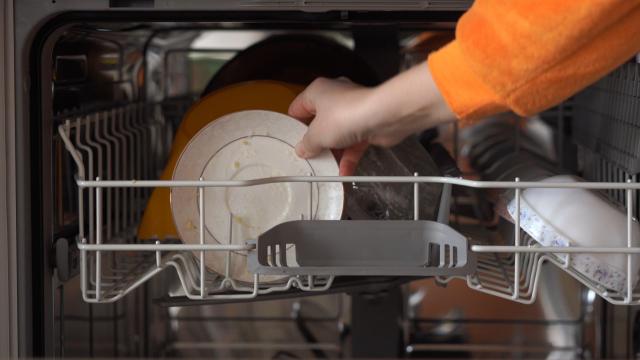You know how to properly clean and how to properly load your dishwasher — so why are some of your dishes coming out dirtier than others? If the last thing you want is to pay for a repair person — or worse, have to buy a whole new machine — you might be in luck. The reason your dishwasher may not be cleaning your dirty plates plates could be as simple as your dishwasher getting too dirty itself.
My knowledge of troubleshooting dishwasher issues comes from my restaurant days. All too often, servers would lug a glass rack upstairs from the dishwasher, only to discover that a full row of glasses were still dirty — even though the neighbouring rows of glasses were perfectly clean. Whenever this happened, we knew the most likely culprit: lemon seeds. Here’s what to know about troubleshooting a clogged dishwasher before you resort to calling in the professionals.
Check the dishwasher’s nozzles for food or debris
Before you assume there’s something wrong with your plumbing or the inner workings of the machine, there might be a much easier fix. Check the nozzles (or wherever water comes out) for food and debris clogging them up. In the restaurant, lemon seeds were known for getting stuck in one nozzle at a time; hence, only a row or two of glasses would miss that nozzle’s spray when they ran through the dishwasher. So, if you’re a fan of drinking a lot of fresh lemon water, or perhaps putting half a lemon in the dishwasher to give your glassware an extra sparkle, make sure you always double-check to remove all the seeds first.
All kinds of food and debris can clog the flow of water in your dishwasher, so look out for any bits that are small and compact (like nuts or seeds) that could get easily jammed in a nozzle. Then again, we advise that you don’t get too crazy pre-rinsing your dishes before running the machine.
Check your filters for food, too
Your dishwasher has a filter at the bottom that is designed to catch all the food and debris that falls off your dishes and could clog your drain. Just like you clear lint from the filter in your dryer, you might need to remove food particles from the coarse filter in your dishwasher.
Food also naturally gets clogged in the dishwasher hose, which typically runs from the dishwasher to the garbage disposal and drain pipe underneath the sink. Luckily, this is another fix you can probably do yourself. Check the accessible bits of the hose (probably under your sink). If you identify a clog, you can likely remove the blockage with a commercial drain cleaner.
How to prevent dishwasher clogs
Prevention is always the best solution to making sure your dishwasher runs as efficiently as possible. Here are some tips for clog prevention, courtesy of Home Depot:
- Remove large crumbs and other leftover food from your dishes before loading the dishwasher.
- Choose a hot water cycle to tackle stubborn, caked-on food.
- Keep your dishwasher clean and in good working order, wiping down the inside and cleaning all the dishwasher parts you can access.
- In addition to checking for clogs where the water comes out, regularly check the filter and remove anything that might be stuck in it.
- Run the dishwasher often to keep operations running smoothly.
If you’ve tried all the above and your dishwasher still doesn’t work like it used to, you might have a more complicated plumbing issue that needs to be checked out by professionals. But for your sake, I hope it’s just a pesky lemon seed in a nozzle.

Leave a Reply
You must be logged in to post a comment.